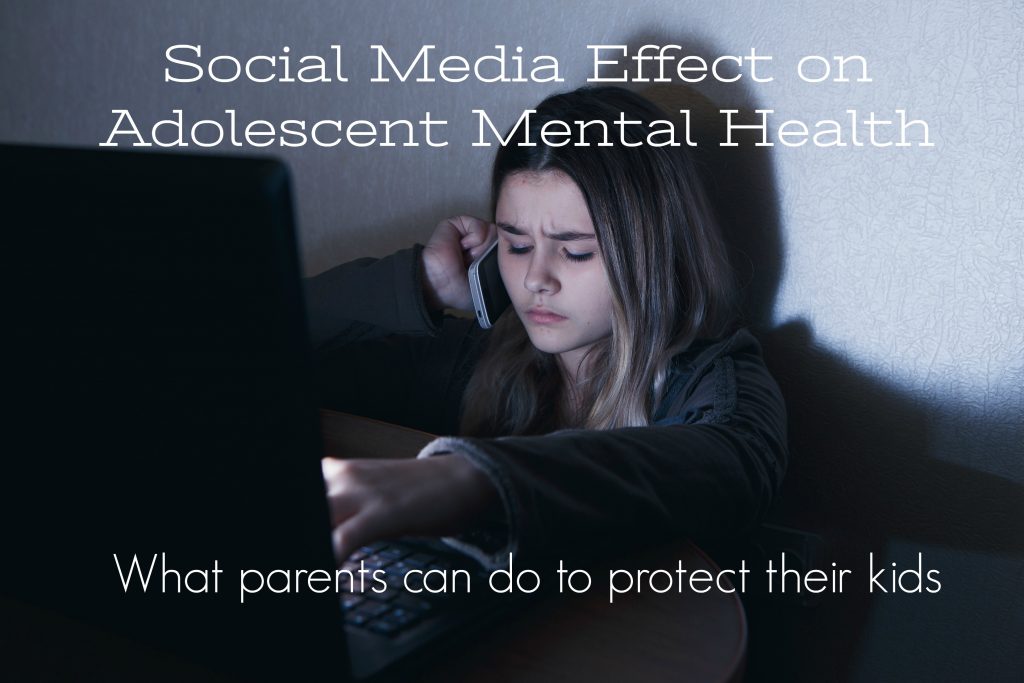Podcast: Play in new window | Download
Subscribe: RSS
Are you worried about your kids’ obsession with their smart phone? Do you know what social media platforms they spend time on? Are you noticing any mood, emotional, or behavior signs that indicate they seem unhappy? A few days ago I read an oped in USA Today from a doctor who wrote about a disturbing increase in female adolescent patients cutting (a form of self-mutilation). While it saddened me, I wasn’t surprised. Recent research in mental health indicates an increase in mental health problems among children and adolescents.Mental health problems among adolescents is increasing at an alarming rate!
While a decrease in some at-risk behaviors is associated with adolescent use of social media, an increase in mental illness is particularly concerning. Here are some findings in a couple of articles on the subject. Psychology Today – It’s Complicated: Teens, Social Media and Mental Health (Sept 2017), Erin & David Walsh – Smart Parenting, Smarter Kids- Heaviest social media users experience the greatest amount of anxiety (FOMO – fear of missing out)
- Young people report social media (sm) helps them feel connected with family and friends.
- One out of five teens feel worse about their life based on what they see on social media.
- Passive scanning of people who appear happy or successful can increase feelings of loneliness, depression, and anxiety.
- Teens/young adults 16-24 yrs old are the most intense users of social media (90% use internet for social networking).
- Overuse has negative impact on self-esteem, life satisfaction, and increases mental health problems (anxiety, depression, suicidality).
- “Likes” activate the brain’s reward system.
- Social media has resulted in a decrease in risky behaviors (drinking, illicit drug use, car accidents, teen birth rates).
- Less than an hour of gaming can have positive mental health effects.
- 8th graders who spend 10 or more hours a week on sm are 56% more likely to report being unhappy, than those who spend less time.
- Heavy users of sm increase their risk of depression by 27%.
- YouTube is viewed as a positive force, but Snapchat, Facebook, Twitter and Instagram increase feelings of anxiety as reported by teens.
- Lack of sleep due to late night sm engagement has effect on mental health:
- Lack of sleep negatively affects, mood, ability to regulate emotions, cognitive processing, ability to react or get along with adults.
- Teens who do not sleep enough are more than twice likely to report higher levels of depression (31% vs 12%)
- Teens who sleep less than 7 hours a night are also 68% more likely to have at least one risk for suicide.
- Negative impact of social media in girls vs boys
- 22% of girls vs 10% of boys reported being cyberbullied in the last year.
- Boys depression increased by 21% vs girls 50% between 2012-2015*
Mental health begins in the home
Let’s examine how you can foster mental health in your family.#1: Take time an reflect on the positive and negative effect electronic devices are having in your family
What are some positive uses of electronic devices in your family? Do any of these apply?- Helps us to stay connected and/or communicate during the day.
- Ability to monitor the kids whereabouts.
- Marking moments of shared family experiences.
- Devices become a barrier to connect when we are at home together.
- Withdrawal patterns in kids.
- Signs of mental health problems emerging.
#2: Examine your relationship with electronic devices
Before you assess your kids, what about you? Think about what you model in the home as you answer these questions:- How often are you on your devices around your family?
- Do you rely on devices to keep your kids occupied when your busy?
- How consistent are you on restricting your kids’ time on devices?
- Does change need to begin with you? If so, what change?
#3: Look for signs that devices and social media are having a negative impact on your kids
Did you notice anything in the research that concerns you about your kid? Is your child or teen overly attached to their device? Any changes in mood, emotional stability, self-esteem, or social connections? Now, if you see a negative behavioral pattern, it is time to talk to your kid. “Be calm” and talk about what you observe and ask some non-judgmental, inquistional curiosity questions.- “You seem down lately, care to talk about it?”
- “You have not been yourself. Let’s talk. I’m all ears.”
 #4: Introduce new family patterns to increase mental health in your home
#4: Introduce new family patterns to increase mental health in your home
How do you do this? Here are 10 suggestions to get you started:
- Start by bringing the best version of your self out of the bedroom in the morning. Set your brain right. Think positive. Establish morning routines that put you in a positive mood.
- Do not allow the negative mood of others to set the tone. Maintain your positive attitude, they will eventually follow.
- If you have mental health problems address them. Remember, mental health in the home begins with you!
- If your kid/teen has a mental health problem get them some help.
- Establish device free or unplugged time in your home to allow you time to connect face-to-face. Morning and evening times are a good place to start
- Set at least one segmented time a week for family fun and everyone is required to participate.
- Establish boundaries on disrespect in the home. Promote healthier ways to work through conflict.
- Have one-on-one time with your kids on a regular basis.
- Give your kids chores.
- If your home is chaotic do family counseling to get everyone on track together.

